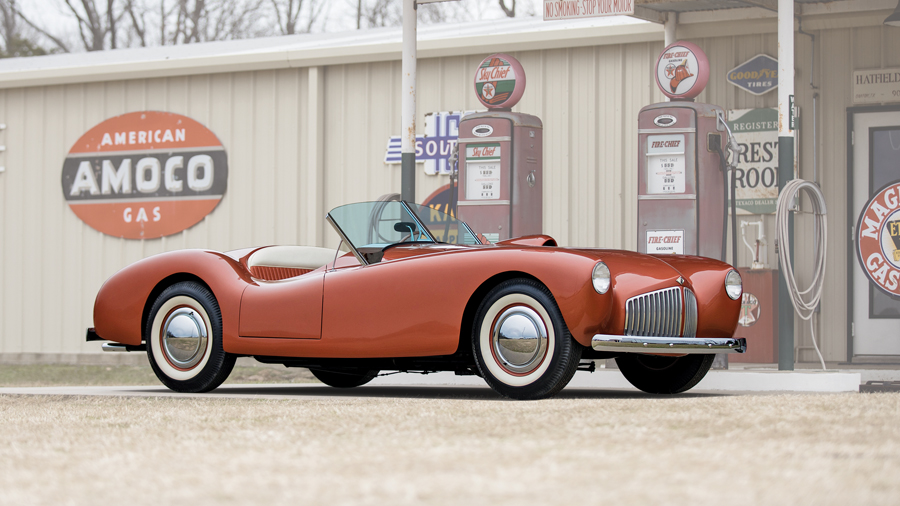- Two-owner example of this rare early sports car
- Original DeSoto Hemi and Ford running gear
- Beautifully restored; just 122 miles since
SCM Analysis
Detailing
| Vehicle: | 1953 Glasspar G2 Roadster |
| Years Produced: | 1953–55 |
| Number Produced: | About 100 |
| Original List Price: | $2,950 |
| SCM Valuation: | $109,200 (this car) |
| Tune Up Cost: | $100 |
| Chassis Number Location: | Right-side door jamb |
| Engine Number Location: | Engine block |
| Club Info: | Glasspar G2 Club (inactive) |
| Website: | http://www.undiscoveredclassics.com |
| Alternatives: | 1953–62 Chevrolet Corvette, 1957–61 Bocar XP-5, 1954 Kaiser-Darrin |
| Investment Grade: | C |
This car, Lot 159, sold for $109,200, including buyer’s premium, at RM Sotheby’s auction on Amelia Island, FL, on March 8, 2019.
Fiberglass was first developed in the 1930s through research carried out at Owens Corning and DuPont, but the material really did not catch on until the 1940s, when polyester resins developed by American Cyanamid during the Second World War became generally available. By 1950, fiberglass was often used to make boats. At the same time, war veterans were busy building hot rods.
In retrospect, the next step was obvious.
Prototyping the future
Glasspar was a boatbuilding company founded in Costa Mesa, CA, by marine architect Bill Tritt. With his proximity to Southern California’s booming custom automotive scene and the friendships he’d made working at Douglas Aircraft during the war, Tritt soon found himself consulting on hot rod bodywork.
Beginning in 1949, Tritt designed and produced the unique Brooks Boxer hot rod body for his friend Ken Brooks. The car was a low-slung 2-seat roadster, with a long, sleek hood and steeply raked windshield. The design owed a lot to the 1948 Jaguar XK 120, but with more glamorous and distinctly Hollywood-inspired curves.
Together with several other fiberglass prototypes, the Brooks Boxer was displayed at the second annual Petersen Motorama car show in November 1951. Unlike conventional manufacturer-based shows, the Petersen extravaganza was all about the latest in design, experimental technology, and even automotive art.
At the Motorama, the Boxer was shown alongside several other fiberglass prototypes, and from there the race was on to create a production car.
Tritt revised the Boxer design with further prototypes. As it happened, one of those prototypes was finished by Tritt’s fiberglass resin partners at the Naugatuck Chemical Company and christened the Alembic I. The Alembic found its way into the hands of GM’s head of design Harley Earl in 1952, and is considered a direct source of inspiration for the Corvette EX-122 prototype.
At the same time, Tritt committed Glasspar to producing a refined version of the Brooks Boxer design, and called it the Glasspar G2. Glasspar also produced several other commissioned adaptations of the base design, such as the Woodill Wildfire, Vaughn Singer, and the Yankee Clipper. Notably, the 1954 Kaiser-Darrin sports car was also based on a Glasspar body, and Kaiser production ultimately exceeded the original Glasspar design.
Production and sales
Glasspar began commercial production of the G2 in 1953, selling the car as a finished roadster or in kit form. The G2 rode on a custom-designed reinforced ladder frame and generally used Ford running gear and a Ford flathead V8 engine, although it could be fitted with a wide variety of engines. The long-hood design allowed Tritt to mount the engine entirely behind the front axle, giving the G2 excellent balance and a curb weight under 2,000 pounds.
Glasspar is known to have completed at least 10 finished cars, including orders for celebrities Gary Cooper and Rosemary Clooney. The purchase price for a turn-key G2 roadster was $2,950, undercutting Chevy’s brand-new Corvette by almost $550. The G2 kit version cost $950 for the body and frame with no running gear, and this was how most were delivered.
The G2 never saw widespread commercial success, with only about 100 examples produced between 1953 and 1955. Glasspar also mass-produced about 100 bodies and frames for the closely related Woodill Wildfire. However, the G2 led to Glasspar being commissioned to produce bodies for Volvo and train the Swedish company’s engineers in fiberglass production techniques. Glasspar also created the first cars for Walt Disney’s Autopia at the new Disneyland theme park in 1955.
Today, about 30 Glasspar G2 examples are known to survive, though it’s likely that at least a few more are still waiting to be rediscovered.
A perfect restoration
The subject car is a 1953 G2, originally sold in kit form. This car was finished with a 1955 DeSoto 291 FireFlite Hemi V8 engine, originally rated at 185–200 horsepower. The transmission, rear axle and the rest of the running gear are Ford-based.
The car remained in the original buyer’s family until it was purchased for restoration and resale. Documentation back to the original sale was included. Judging by the photos provided, the restoration is well done. Certainly it is far better than any kit-built car from the 1950s would have been on the day the owner first turned the key.
RM Sotheby’s estimated the market for this unique piece of American automotive history at $65,000 to $90,000, but the final price of $109,200 shows that buyers are eager to bid with confidence for the best of the best in terms of restoration, provenance and quality. When you consider that a similar G2 with a much-less-respectful restoration was offered at $130,000 and sold last year, the money paid for this one looks very attractive.
The takeaway from this sale is simple: Ignore all doomsayers who predict the imminent collapse of the classic-car market, because there will always be strong demand for cars of this caliber.
(Introductory description courtesy of RM Sotheby’s.)
